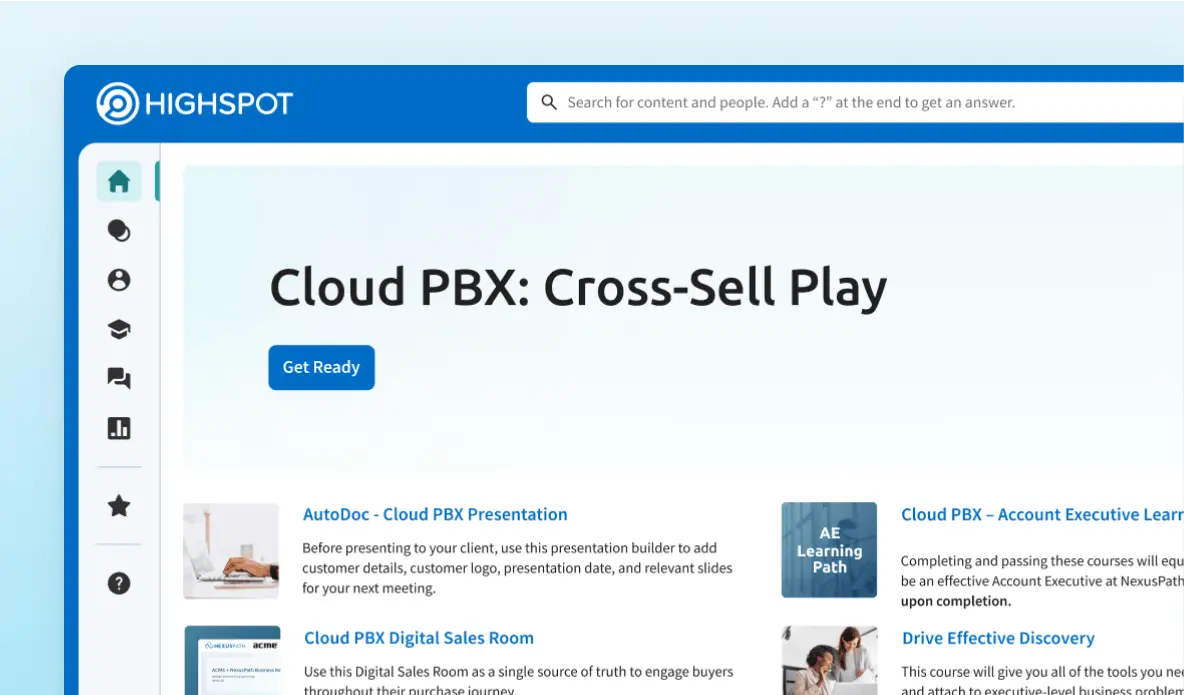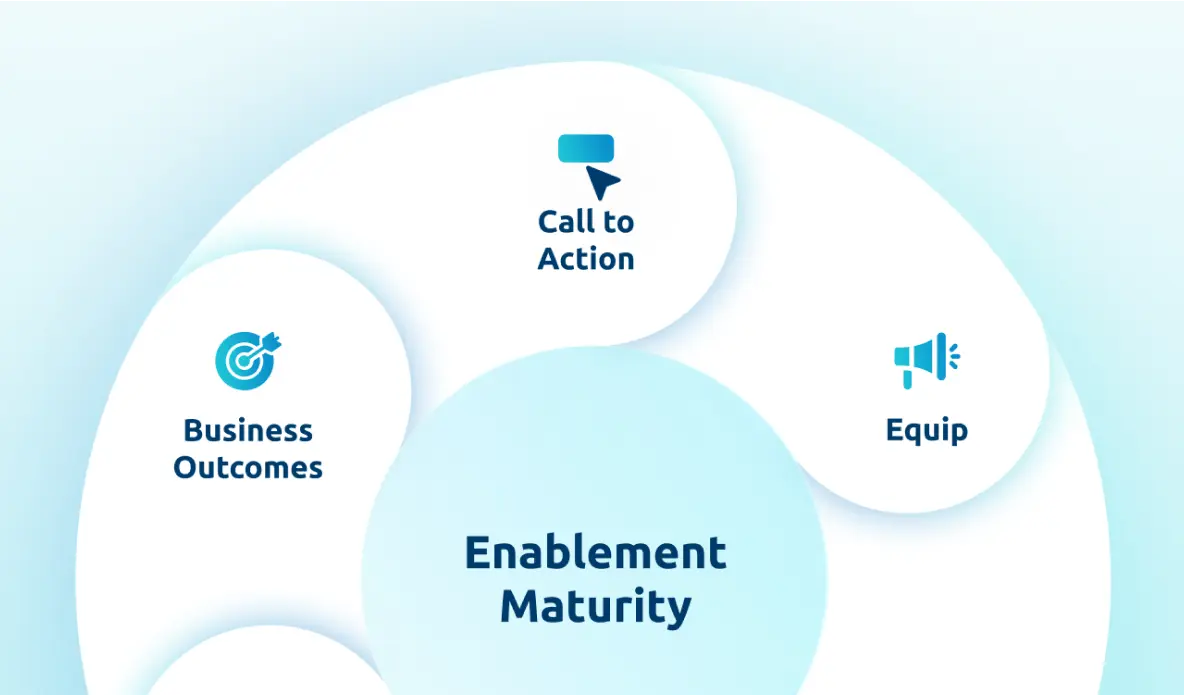According to The Times, employees now face an average of nine organizational changes per year, up from two before 2020, leading to increased change fatigue. So, how can you lead a change management strategy to help reps effectively navigate these changes?
Shawnna Sumaoang: Hi, and welcome to the Win-Win podcast. I’m your host, Shawnna Sumaoang. Join us as we dive into changing trends in the workplace and how to navigate them successfully.
Here to discuss this topic is Sobia Younus, the senior manager of sales learning and enablement at ApplyBoard. Thank you for joining us, Sobia. I’d love for you to tell us about yourself, your background, and your role.
Sobia Younus: Sure. I really appreciate this opportunity. So I’m leading the sales learning and enablement team at ApplyBoard, a leading ed-tech platform that’s reshaping how international students access global education. So I lead a global sales enablement framework that focuses on performance process and people and my role.
Spans everything from onboarding and ever boarding to performance improvement initiatives that firsthand impact the revenue. But to rewind a bit, my journey has never been linear, and I believe that’s been my strength. So while I’ve always been rooted in international education, my niche has always been B2B and B2C sales, and that helped me build a strong understanding of client behavior, market trends, and grow through meaningful engagements.
I have been with ApplyBoard for almost six years. I initially joined the CX team, which gave me insight into the student journey and operations side of how applications are being processed. From there, I transitioned into the sales role where I gained the firsthand experience of navigating the field.
Finally in 2021, I moved into sales enablement, and that’s where everything came together. It blended my passion for education, my CX foundation, and my love for sales performance into one purpose driven role. I think today I focus more on building scalable strategic enablement programs that build and drive revenue, empower people, and connect the dots between learning, growth and results.
Personally, to me, and I really wanna share that, I believe that for me, enablement is where storytelling meets the strategy. That’s what make it so exciting, and what excites me the most about my work today is the blend of strategy and human behavior. Most importantly, understanding how people learn, they stay motivated, and how the right tool and messaging can turn a sales team into a high performing empowered force. That’s why I’m so excited to be here today because platforms like Highspot make a real difference.
SS: Amazing. Well, we’re excited to have you here, and given your extensive experience in education management, I’d love to learn from you what are some of the unique challenges that reps in the industry face, and how can enablement help them navigate these challenges?
SY: So that’s a very important subject. So one of the most unique aspects of international education industry is how deeply it influenced by external elements like immigration reforms, global mobility trends, and even geopolitical shifts. So unlike other industries where salespeople can rely on relatively stable products or markets, education is often at the mercy of forces beyond control.
And as a result, salespeople in this space aren’t just selling a service. They’re actually navigating constant change, managing expectations, and often having to realign their strategy in real time. And a great example is what recently we saw last year, the government introduced caps on your international student permits and tightened eligibility for post-graduation work.
Permits. So these changes had an immediate impact on student demand, also program selection and school preferences. So practically overnight, our sales rep has to understand the implications, shift focus away from programs that no longer align with student goals and reposition alternatives that still offered strong appeal to students.
This is where enablement became mission critical. And an apply board. We don’t just see enablement as a static function. It is a real time strategic engine that basically supports business agility. So within days of those updates, our team not only delivered the sessions, so we created and rolled out sales plays and updated talk tracks and Highspot.
We designed objection handling strategies on Highspot to help our. Salespeople reposition options with clarity and assurance. So in short, we didn’t just inform, we equipped, so that is important. Our goal was to turn uncertainty into clarity so that salespeople could keep on building trust and drive impact through their communication.
And I believe that enablement also reinforces a culture of agility. So in industries like ours, change is inevitable. But when enablement is done right. It actually becomes a competitive advantage.
SS: Amazing. And I know that at ApplyBoard, you actually switched off a previous enablement platform and moved to Highspot. What motivated you to reevaluate and change your enablement tech stack?
SY: So when we initially built our enablement infrastructure at Apply board. Our primary focus was on structured learning. So naturally our, you know, tech stack leaned towards a traditional LMS. It served its objective at that time, like building onboarding courses and track completion.
But as our sales organization matured. So did the scope of our needs. So we realized that enablement couldn’t just live in siloed training modules. It had to be integrated into the daily flow of work. And our sales team needed not just learning, but relevant and up to date resources and real time support to navigate, you know, fast-paced industry changes.
So in short, we needed more than an LMS. We needed a true enablement platform that could function as a CMS, a single source of truth, and I would love to call Highspot a strategic one-stop shop. So that’s what motivated our ship to Highspot. We wanted a one-stop solution where onboarding and ever boarding training and sales plays and competitive insights all could live together.
A platform that doesn’t just share knowledge, but it gives. To our salespeople when they need it in a way that fits how they work. So it was a mindset shift from how do we train people to how we enable performance? And Highspot gave us the ash to just do that.
SS: Change management is absolutely crucial, especially during major product or policy updates. What are some of the common pitfalls that organizations can face during change and how can they avoid them?
SY: It’s a very crucial issue, and it is often underestimated and not because organizations don’t recognize its importance, but because they assume communication alone is enough. One of the most typical pitfalls is treating change as an announcement rather than a proper process.
So when major product updates or you know, changes happen, especially in the industry like international education where external shifts can be sudden and high stake, simply informing teams isn’t enough. You need to enable them. So, and other pitfall that I wanna mention over here is failing to connect the why behind the change.
So, if sales reps or CX teams don’t understand how an update or change a product shift ties back to their goals or the client’s goals. It usually creates resistance. Or worse disengagement. So change without clarity leads to confusion. And I always believe that change without a proper plan leads to chaos.
So one more typical misstep that I wanna mention over here is not planning for reinforcement. So even when the rollout goes smoothly, but without a continuous enablement, like quick one pages or talk tracks, or life scenarios and sales place, trust me, all behavior will return. People default to what they know when things get tough, you know?
But at ApplyBoard, we’ve learned this through the hard way, that effective change management start with empathy and end spend with enablement. So we ensure teams understand the work, the why, and how of every change, and we don’t stop at emails. We provide field ready tools, align managers as change champions, and use platforms like Highspot to make resources easily accessible and track the engagement, which is very important.
So we all know that change is inevitable, but chaos is optional and you can do wonders if you treat enablement as a bridge between strategy and execution.
SS: In your opinion, what is the strategic advantage of an enablement platform when navigating change?
SY: So, in my opinion, the strategic advantage of an enablement platform during especially the time of change, is simple.
It turns information into action at scale and in real time. So change, especially in the fast moving industries like international education. Often creates a gap between what the business knows and what the field needs. So product evolves, policies, they change and market fluctuates. But if your sales teams can’t access the right information at the right moment, trust me, execution suffers.
So this is where an enablement platform becomes mission critical. It just centralizes the word, the why and how of change into one cohesive experience. So instead of scattered emails, you know, outdated decks or reactive training sessions, you get a single source of truth, which is updated, which is searchable, relevant, and embedded in the daily workflow.
I’m so glad to say that at Highspot has given us the ability to roll out updates with precision and speed, and when major changes hit, you know, like the recent PGWP reforms, we can respond with focus sales plays, updated talk tracks, training modules, and enablement briefs in one place. We are not just informing the salespeople, we are empowering them to act immediately with clarity, with the right message.
So that’s the advantage of a strong sales enablement platform like Highspot, that it turns change into action. It aligns teams to keep a clear narrative, gives clear visibility into what’s working, also helping you execute with assurance and stay ahead.
SS: And I know Plays have been a key lever in helping your reps navigate change, such as, you know, with a recent government policy update that impacted your go-to-market strategy, how did you leverage plays to support this initiative and, and ensure global team alignment?
SY: So to be very honest, Sales Plays have become one of our most powerful tools for driving clarity during moments of change. A great example, as you said, and I mentioned earlier as well, the IRCC updates last year, that significantly impacted which programs and institutions were feasible for students creating a sudden shift in our go-to market approach as well.
So we knew that without quick and organized actions, this could lead to inconsistent messaging, confusion in the field and you know, lost trust with our clients as well. So we leaned heavily on sales plays and Highspot to bring structure to the chaos. So first we worked cross-functionally with the product team CX and the market expert to streamline these changes into actionable insights.
So we took it this way, so we help them understand what it meant. What was changing and how it impacted our clients and the students. Then we created some tailored sales plays that included updated talk tracks to help salespeople position alternatives with with clarity and empathy and segmented school lists like highlighted eligible and ineligible programs, suggested outreach. Templates and objection handling approach. Also, we did some live enablement sessions to walk them through our strategy and create some space for q and a as well. But most importantly, next steps for the salespeople. And because the sales play lived in Highspot, we could monitor.
The engagement, the usage, and the adoption globally. So this gave us clear visibility into where reinforcement was needed and allowed the regional leaders to support their teams more effectively. And honestly, in moments like these sales plays are a vehicle for alignment, clarity, and assurance. They help us go from reactive to proactive insurance.
Our teams aren’t just informed, but they’re ready.
SS: That’s impressive. And you also implemented a Learning Tuesday initiative to drive engagement, which has helped you achieve a remarkable 91% recurring usage in Highspot. Could you share more about this practice and, and how you’re driving adoption of the platform amongst your reps?
SY: So one of the most important lessons that I have learned in my enablement journey is this. If you want to build a culture of learning, don’t push your salespeople, walk in their shoes. So understand their reality, their pressures, and how they spend their day and apply aboard are salespeople are constantly engaging with clients, pitching multiple destinations, helping clients navigate multiple schools and programs.
So for them to be effective, clarity is everything. And it comes from knowing your product, your destination, your message by heart. And that insight shaped our approach to drive Highspot adoption as well. So instead of just treating enablement as a checklist, we focus on making learning relevant, timely, and useful.
So that’s where Learning Tuesday was born. It’s a recurring initiative, you know, to share short, impactful learning that fits easily into the flow of the week. So each Tuesday we choose a specific focus area of our sales team, whether it’s like a destination or a school or a program or any product update and build a supporting asset and a quick quiz in Highspot to provide timely, practical resource that aligned with what salespeople are actively navigating in the field.
So the goal was simple. Like make learning part of their workflow, not an interruption to it, you know? And it’s very important to understand. And because we use Highspot to highlight success stories across the teams. So this approach helped us reach a 91% recurring usage rate and Highspot, because salespeople weren’t being told to learn.
They chose to learn and it was because the assets and focus areas were so relevant, timely, and help them, uh, do their jobs. And I believe that and its score that enablement isn’t just about sharing information. It is about supporting people by giving them the right tools and add the right time and helping them see the difference it makes
SS: Again, impressive. And as a results driven leader, what are some of the key metrics that you track to effectively drive change initiatives?
SY: That’s a great point. And you know, one that really reflects how enablement has evolved as a function, especially in ApplyBoard, so early in our enablement journey. Like many other teams, we are primarily focused on the surface level metrics, like number of views and number of assets viewed, and or how often an asset was viewed.
But we quickly realized those numbers can be misleading. For instance, if two people viewed three assets a hundred times, the view count may look impressive, but it doesn’t tell you anything about who’s engaging, how many people are engaging or whether it is actually driving behavioral change. So we took a step back and asked ourselves that, what does meaningful engagement look like?
What actually signals that our enablement efforts are influencing performance. So that led us to create a more focused Highspot performance, you know, engagement framework, one that actually prioritizes impact over bulk. So we started tracking metrics that showed the full picture of how salespeople were using and applying enablement in their work.
I will share some examples, like number of unique people viewing the assets, not just the total views, monthly and weekly hours spent on Highspot, both overall and segmented by the projects. Also, the completion rates of assessments and the onboarding courses. Especially tied to the onboarding milestones and also initiatives like Learning Tuesdays.
Also, engagement with the sales players and the field tools, especially during the moments of change. And when I say engagement, I mean time spent on these assets and how many people viewed the assets, and most importantly, a correlation. Between Highspot engagement and sales OKRs, like win rates or ramp-up time.
So this shift actually helped us move from reactive reporting to proactive decision making. So instead of just knowing what’s being clicked or now we understand what’s actually being used. What is actually being retained and you know, what is actually impacting their performance. So it has helped us improve our, you know, Highspot approach by removing the low performing resources and focusing more on what actually helps our salespeople in the field.
And I believe that an enablement metrics shouldn’t just measure activity. They should measure momentum. And when you focus on the right ones, they become a powerful lever for driving lasting change.
SS: Amazing. Well, Sobia, I’m hoping you can share with me. Since implementing Highspot, what business results have you achieved and do you have any wins you can share?
SY: So many. I can gladly say that. So many wins since we started using Highspot. So many wins. So we have seen some clear improvements in key sales performance metrics that support our business goals. While many things can influence results like market changes or team growth, but enablement has played a very important role in keeping that progress going.
Like I said earlier in international education and ed tech sector, things move fast. We are always dealing with changes, immigration updates, and new information, and at the same time, we are growing quickly and bringing in people from all sorts of industries. So some with sales experience, but little international education experience and knowledge and others with the opposite.
So enablement helps bridge that gap early on. This mix actually led to longer ramp up times, like longer than typically 50 to 60 days. As a new hire, they were learning about both the product and the education sector. So you know, it was taking a lot of time for them to learn all of that. But by building a structure.
Role-specific onboarding program within Highspot. We changed the game, our onboarding program. Now delivers destination training, platform fluency, and process enablement all in one centralized, searchable space, high sport. So as a reserve, we’ve successfully brought ramp up time just under 30 days on average.
So the acceleration has had a clear impact on early client engagement and revenue readiness. Highspot just didn’t, you know, help us organize the asset. It helped us succeed. Successfully execute onboarding, scale their learning across borders, and you know, prepare salespeople to thrive in one of the most dynamic industries out there.
Also, I can say this with assurance that enablement helped translate change into action, and Highspot was the strategic engine that allowed us to do that with speeds, scale and clarity.
SS: Last question. If you could share one crucial lesson learned from your experience supporting teens through change, what would it be?
SY: So, one very crucial and important lesson that I’ve learned is that successful change isn’t about having all the answers. It’s about creating alignment, trust, and momentum. So I’ve seen that teams respond best when they understand the why. Feel heard in the how. Can see themselves in the what’s next? So change sticks when it’s not just implemented, but truly internalized.
And you know, that’s where sales enablement plays a crucial role by equipping teams with the right messaging, timely training, and actionable resources to navigate change with clarity and assurance and platform like Highspot make that happen successfully at scale.
SS: Sobia, again, thank you so much for joining us. I really appreciate your insights.
SY: I really appreciate that you having me here. It’s a pleasure and I truly enjoyed sharing, you know, all of the experience and learning.
SS: To our audience, thank you for listening to this episode of the Win-Win podcast. Be sure to tune in next time for more insights on how you can maximize enablement success with Highspot.



